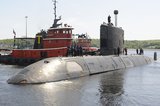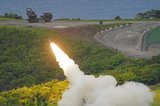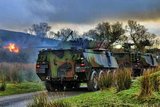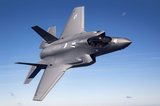Sea Air Space 2011: Raytheon outlines growth path for ESSM
NATO countries operating the maritime Evolved SeaSparrow Missile (ESSM) have expressed an interest in an extended range variant to compete with earlier derivations of the in-service SM-2 Standard Missiles, according to Raytheon officials.
Speaking to Shephard at the Navy League Sea Air Space exposition, ESSM programme director Edward Roesly said a number of SeaSparrow operating nations had approached Raytheon with such a request. However, he warned that the US was 'not supportive' of this initiative at the present time as it would lead to competition with its SM-2 missile system. Today, ESSM is used by Australia, Canada, Denmark, Germany, Greece, Netherlands, Norway, Spain, Turkey and the US.
The in-service Block I ESSM is designed for ship protection against anti-ship missiles; aircraft; helicopters; and surface targets out to approximately 40km, Roesly said. The SM-2, also manufactured by Raytheon, boasts ranges between 130km (Block II) and 170km (Block IIIB), not to mention its Block IV extended range version which can engage targets up to 240km away. Raytheon was unable to comment on what would be substantial range increases for an extended ESSM variant to match SM-2 capabilities.
In addition, Roesly said Raytheon was also developing a new warhead as part of the same Block II upgrade although he could only admit that it would provide 'flexibility for lethality'. The Block II system is expected to reach an initial operating capability in 2015. Other improvements will include guidance upgrades and ESSM's own active radar system.
'We are in risk reduction right now with the EMD [engineering manufacturing development] due to start in 2014 and an initial operating capability in 2018/19,' Roesly added.
Meanwhile, moves are also afoot to equip the US Marine Corps' last remaining Tarawa LHA-1 class amphibious assault ship with ESSM, although Roesly conceded that this would not materialise for another three to four years.
Finally, Raytheon said it was interested in pitching ESSM to countries operating SA-6 and Hawk missiles with plans afoot to demonstrate its capability in Poland next year. SA-6 launchers are already compatible to fire the ESSM missile and Roesly admitted that there were a number of requirements in eastern Europe including not only Poland but also the Czech Republic.
More from Defence Notes
-
![How might European countries look to tackle drone incursions?]()
How might European countries look to tackle drone incursions?
Disruption of infrastructure in Europe, whether by cyberattack, physical damage to pipelines or uncrewed aerial vehicles flying over major airports, as has happened more recently, is on the rise. What is the most effective way of countering the aerial aspect of this not-so-open warfare?
-
![Taiwan approved for $11 billion weapon purchase from US]()
Taiwan approved for $11 billion weapon purchase from US
The US State Department’s approval of a multi-billion-dollar sale of weapons to Taiwan includes tactical mission networks equipment, uncrewed aerial systems, artillery rocket systems and self-propelled howitzers as well as anti-tank guided missiles.
-
![Ireland spells out $2.3 billion shopping list in five-year defence spending plan]()
Ireland spells out $2.3 billion shopping list in five-year defence spending plan
Ireland’s multi-annual investment in capital defence spending is set to rise from €300m in 2026 to €360m in 2029–2030 with major upgrades across land, air, maritime and cyber domains.
-
![Canada to deepen integration of multi-domain capabilities to strengthen its defences]()
Canada to deepen integration of multi-domain capabilities to strengthen its defences
The Canadian Department of National Defence has created new organisations to manage the procurement and integration of all-domain solutions and allocated US$258.33 million to strengthen production capacities.
-
![US National Security Strategy prioritises advanced military capabilities and national industry]()
US National Security Strategy prioritises advanced military capabilities and national industry
The 2025 NSS has emphasised investment in the US nuclear and air defence inventory and national industry, but it leaves multiple unanswered questions on how the White House will implement this approach.
-
![Canada set to look away from its neighbour and across the Atlantic for partners]()
Canada set to look away from its neighbour and across the Atlantic for partners
While non-EU UK struggles to join the Security Action for Europe initiative, which provides loans for defence programmes, Canada has become the first country outside Europe to get access – and did so for a nominal fee.
























